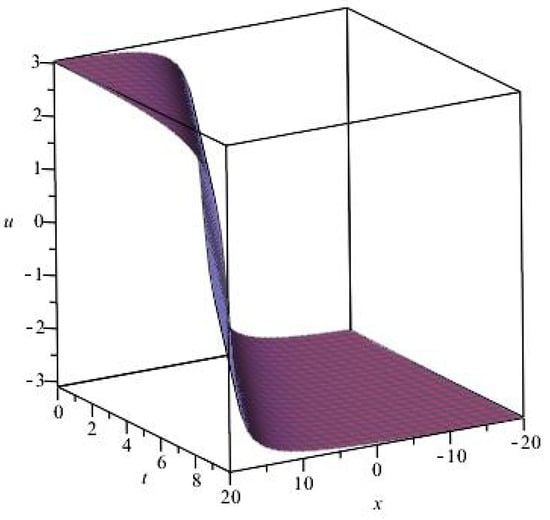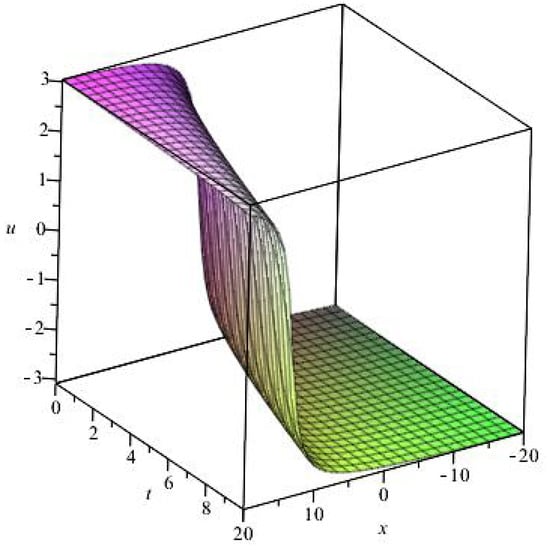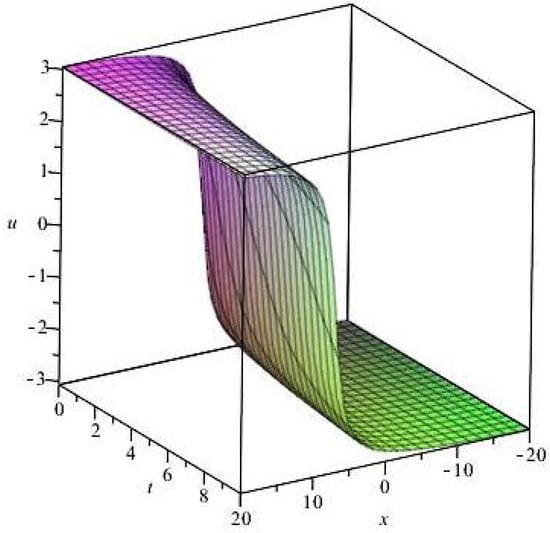Abstract
In this paper, the extended double (2+1)-dimensional sine-Gorden equation is studied. First of all, using the symmetry method, the corresponding vector fields, Lie algebra and infinitesimal generators are derived. Then, from infinitesimal generators, the symmetry reductions are presented. In addition, these reduced equations are converted into the corresponding partial differential equations, which including classical double (1+1)-dimensional sine-Gorden equation. Moreover, based on the Lie symmetry method again, these reduced equations are investigated. Meanwhile, based on traveling wave transformation, some explicit solutions of the extended double (2+1)-dimensional sine-Gorden equation are obtained. Consequently, a conservation law is derived via conservation law multiplier method. Finally, especially with the help of the fractional complex transform, some solutions of double time fractional (2+1)-dimensional sine-Gorden equation are also derived. These results might explain complex nonlinear phenomenon.
1. Introduction
Recently, Wang, from extended Lax pairs, derived a (2+1)-dimensional sine-Gorden Equation [1],
they studied the kink wave and anti-kink wave solutions, also derived conservation laws. Based on the results of ref. [1], this paper focuses on the following extended double (2+1)-dimensional sine-Gorden equation:
and time fractional form as follows:
where is the modified Riemann–Liouville derivative [2,3,4], , a is a constant. Some preliminaries of the modified Riemann–Liouville derivative refer to [2,3,4]. If , Equation (2) reduced to Equation (1). Furthermore, it can be seen that if , Equation (3) becomes Equation (2). This paper extends our previous work in [1] to study the extended double (2+1)-dimensional sine-Gorden equation. The sine-Gorden-type equation appears in many science fields [5,6], such as nonlinear optics, quantum field theory, differential geometry, solid state physics and so on. The author [7] derived multiple optical kink wave solutions of sine-Gordon-type equations. In paper [8], they got some exact solitary wave solutions for sine-Gordon-type equations using an auxiliary ordinary differential equation method. In [9], they considered initial value problem for the sine-Gordon equation, this equation is solved by the inverse-scattering method. The author, in paper [10], using tanh method and a variable separated ODE method, solved double sine-Gordon equation, and some exact solutions are derived.
There are many methods to study the nonlinear evolution equations, such as the Lie symmetry method [11,12,13,14,15,16,17,18,19,20,21,22], Hamiltonian system [23,24,25,26], Hirota’s bilinear direct method [27], Bcklund transformation [28,29], inverse scattering transformation [6], Darboux transformations [30], Lax pairs [31,32] and so on. On the other hand, it is well known that fractional order differential equations are well suited to characterize materials and processes with memory and genetic properties, and their description of complex systems has the advantages of simple modeling, clear physical meaning of parameters, and accurate description, thus becoming one of the important tools for mathematical modeling of complex mechanics and physical processes [33,34,35,36]. With the development of science and technology, most of the problems in real-life natural phenomena such as optical and thermal systems, rheological and material and mechanical systems, signal processing and system identification, control and robotics, and other applications can be described by fractional order differential equations [37,38,39,40,41,42]. Therefore, the research on fractional order differential equations has also received extensive attention from more and more authors, especially the fractional order differential equations abstracted from practical problems have become a hot research topic for many mathematicians. As fractional order differential equations appear in more and more scientific fields, the study of both theoretical analysis and numerical computation of fractional order differential equations is particularly urgent [37,38,39,40,41,42]. This is because it can better explain the complex natural phenomena.
Lie symmetry method provides a powerful and fundamental framework to the investigation of differential equations, it can link between different differential equations, it also can construct conservation laws for differential equations. As this equation is obtained from the extended Lax pair and this equation can be reduced to the classical sine-Gorden equation, it is necessary to study this equation to provide stronger theoretical support for solving practical problems. The current paper is divided into the following main sections, in Section 2, the extended double (2+1)-dimensional sine-Gorden equation is studied using symmetry method. In Section 3, symmetry reductions and analytical solutions of the extended double (2+1)-dimensional sine-Gorden equation are presented. A conservation law is given by Section 4. Explicit solutions of the extended double time fractional (2+1)-dimensional sine-Gorden equation are obtained in Section 5. The last Section is the conclusion of this paper.
2. Symmetry Analysis of the Extended Double (2+1)-Dimensional Sine-Gorden Equation (2)
Given the following vector fields [11,12,13,14,15,16,17,18,19,20]
where
Consider the connection of vector field (4) and symmetry of the extended double (2+1)-dimensional sine-Gorden equation, V needs to satisfy Lie’s symmetry condition
where
Given the second prolongation
to the (2), the following infinitesimal criterion reads as
where
and so on and here is the following total derivative operator
and .
After calculation, the following results are derived:
where are arbitrary functions of . Therefore, from Equation (4), the following infinitesimal generators are obtained:
where
It is clear that if the appropriate functions for , and are selected, an infinite number of symmetries are presented. Obviously, there are basic infinitesimal generators
Their Lie algebra and commutative relations are given by
Based on the Lie group method, if is a solution of the extended double (2+1)-dimensional sine-Gorden equation, so are
and so on. In next section, some analytical solutions will be investigated.
3. Symmetry Reductions and Analytical Solutions of the Extended Double (2+1)-Dimensional Sine-Gorden Equation (2)
3.1. Symmetry Reductions
3.1.1.
For generator , the invariant function is , where are invariants; therefore, the following partial differential equation (PDEs) are derived:
It needs to be emphasized that this equation is just famous double (1+1)-dimensional sine-Gorden equation.
3.1.2.
For vector , the invariant function is and invariants are . Thus, they generate following PDE
3.1.3.
Considering , the invariant function and invariants are and , respectively. For this case, following PDE is presented
3.1.4. Traveling Wave Transformation
Given and , one can get the following PDE
3.2. Symmetry Analysis of Reduced Equations
3.2.1. Lie Symmetry of Equations (17) and (18)
For these PDEs, one can obtain the infinitesimal generators as follows:
3.2.2. Lie Symmetry of Equation (19)
For this PDE, the following infinitesimal generators are derived
Of course, these equations can continue to be handled in the same way and with the same steps as before. For the sake of simplicity, they are not listed in detail.
3.3. Analytical Solutions of the Extended Double (2+1)-Dimensional Sine-Gorden Equation (2)
In previous section, a ODE is derived via traveling wave transformation. Now, one can study this ODE (20).
For the extended double sine-Gordon equation, using the traveling wave transformation
that can be converted to the following ODE
or equivalently form
From the above analysis, it can be seen that in order to guarantee the existence of solutions, it is required that k is not equal to 1. Assuming that satisfies the following ODE:
where and are constants need to be fixed, also the positive integer n can be fixed via the leading-order analysis method. In this way, one can get , thus we have
where and are constants that will be determined. Differentiating (27) with respect to gives
Comparing (28) with (25) it can be found that has to equal to zero. Therefore, one can obtain
that is to say,
It can be seen that Equation (27) is separable, hence one can have
where by integrating both sides, the following solutions [8] are derived
where is the constant of integration. These solutions are solitary wave solutions, they have obvious physical implications, that is to say, the wave form does not change with time in the propagation process, and outside the zone of interaction (the collision zone), the solitary wave retains its shape and velocity. Therefore, in turn, it can be derived that the following analytical solutions
for ,
for ,
4. Conservation Laws of Equation (2)
A conservation law express the following form:
By using conservation law multiplier method [13], let
Therefore, one can get
the total derivative operators satisfy solutions of Equation (39). Solving for every u in Equation (39), one should get a multiplier .
Theorem 1
([13]). Consider the divergence expression one can have
where is the Euler operator given by
Theorem 2
Theorem 3.
Consider second order multiplier , and arbitrary constant a, Equation (39) has a local conservation law
in other words,
Proof.
Consider Equation (43), one gets
Solving these equations, one can obtain
where is arbitrary constant. Thus, it shows that Theorem 3 holds. □
5. Analytical Solutions of the Extended Double Time Fractional (2+1)-Dimensional Sine-Gorden Equation (3)
For the extended double time fractional (2+1)-dimensional sine-Gorden Equation (3), using the fractional complex transform [3,4] , and , substitute them into Equation (3),
should be converted to the following ODE as follows
If we assume , this requirement is not equal to . Without loss in generality, we assume . It can be found that k also cannot be equal to 1 in order to guarantee the existence of the solution. This means that after fractional complex transform, it also becomes the same ordinary differential equation as Equation (24). If is equal to 1, it is the classical traveling wave transform. In this way, using the results obtained above, one can directly obtain solutions of the fractional order differential equation as described below
for ,
for ,
The above analysis shows that if , these solutions are transformed into Equations (35)–(37).
Take the following solution as an example to describe how the solution changes with different . Let , one can get . Figure 1, Figure 2, Figure 3 and Figure 4 depict the solution for different at .

Figure 1.
.

Figure 2.
.

Figure 3.
.

Figure 4.
.
The following Figure 5 shown the solution with different at . As can be seen in Figure 5, the location of the solution changes as changes. The larger the value of , the more forward the solution is located, and conversely, the smaller the value of , the more backward the solution is located.

Figure 5.
Plots of solutions with different at .
6. Conclusions
In this paper, the extended double (2+1)-dimensional sine-Gorden equation and its time fractional form are studied. It is clear that this paper generalizes the results in the literature [1]. This equation not only has extra terms , but also has the time fractional order form of this equation. More importantly, some explicit solutions are obtained.
The extended double (2+1)-dimensional sine-Gorden equation is reduced to a double (1+1)-dimensional sine-Gorden equation by the group method. In addition, it can be found that this equation has basic symmetries. By these basic symmetries, symmetry reductions are obtained. Furthermore, some exact solutions of the extended double (2+1)-dimensional sine-Gorden equation are obtained using traveling wave transform. After that, a conservation law of this equation is obtained based on the conservation law multiplier method. Meanwhile, using the fractional complex transform, some new explicit solutions of the extended double time fractional (2+1)-dimensional sine-Gorden equation also presented.
Consequently, the extended double (2+1)-dimensional sine-Gorden equation is an interesting new equation in nonlinear mathematical physics fields, it should be noted that there are still many issues worth investigating, such as non-local symmetry, non-local conservation laws and many more explicit solutions.
Author Contributions
Writing-original draft preparation: G.W.; Formal analysis, L.L.; Investigation, Q.W.; Writing—review and editing, J.G. All authors have read and agreed to the published version of the manuscript.
Funding
This work is supported by Natural Science Foundation of Hebei Province of China (No. A2018207030), Youth Key Program of Hebei University of Economics and Business (2018QZ07), Key Program of Hebei University of Economics and Business (2020ZD11), Youth Team Support Program of Hebei University of Economics and Business.
Institutional Review Board Statement
Not applicable.
Informed Consent Statement
Not applicable.
Data Availability Statement
Not applicable.
Acknowledgments
We would like to thank the anonymous reviewers and editors for their valuable comments and suggestions, which led to the improvement of the quality of this paper.
Conflicts of Interest
The authors declares no conflict of interest.
References
- Wang, G.; Yang, K.; Gu, H.; Guan, F.; Kara, A.H. A (2+1)-dimensional sine-Gordon and sinh-Gordon equations with symmetries and kink wave solutions. Nucl. Phys. B 2020, 953, 114956. [Google Scholar] [CrossRef]
- Jumarie, G. Modified Riemann–Liouville derivative and fractional taylor series of nondifferentiable functions further results. Comput. Math. Appl. 2006, 51, 1367–1376. [Google Scholar] [CrossRef] [Green Version]
- Li, C.; Guo, Q.; Zhao, M. On the solutions of (2+1)-dimensional time-fractional Schrödinger Equation. Appl. Math. Lett. 2020, 94, 238–243. [Google Scholar] [CrossRef]
- Li, Z.B.; He, J.H. Fractional complex transform for fractional differential equations. Math. Comput. Appl. 2010, 15, 970–973. [Google Scholar] [CrossRef] [Green Version]
- Perring, J.K.; Skyrme, T.H. A model unified field equation. Nucl. Phys. 1962, 31, 550. [Google Scholar] [CrossRef]
- Ablowitz, M.J.; Segur, H. Solitons and the Inverse Scattering Transform; SIAM: Philadelphia, PA, USA, 1981. [Google Scholar]
- Wazwaz, A.M. Multiple optical kink solutions for new Painlevé integrable (3+1)-dimensional sine-Gordon equations with constant and time-dependent coefficients. Optik 2020, 219, 165003. [Google Scholar] [CrossRef]
- Xie, Y.X.; Tang, J.S. A unified approach in seeking the solitary wave solutions to sine-Gordon type equations. Chin. Phys. B. 2005, 14, 1303–1306. [Google Scholar]
- Ablowitz, M.J.; Kaup, D.J.; Newell, A.C.; Segur, H. Method for solving the sine-Gordon equation. Phys. Rev. Lett. 1973, 30, 1262. [Google Scholar] [CrossRef]
- Wazwaz, A.M. The tanh method and a variable separated ODE method for solving double sine-Gordon equation. Phys. Lett. A 2006, 350, 367–370. [Google Scholar] [CrossRef]
- Bluman, G.W.; Kumei, S. Symmetries and Differential Equations; Springer: New York, NY, USA, 1989. [Google Scholar]
- Olver, P.J. Application of Lie Group to Differential Equation; Springer: New York, NY, USA, 1986. [Google Scholar]
- Bluman, G.W.; Cheviakov, A.; Anco, S. Applications of Symmetry Methods to Partial Differential Equations; Springer: New York, NY, USA, 2010. [Google Scholar]
- Wang, G.W.; Kara, A.H. A (2+1)-dimensional KdV equation and mKdV equation: Symmetries, group invariant solutions and conservation laws. Phys. Lett. A 2019, 383, 728–731. [Google Scholar] [CrossRef]
- Wang, G.; Vega-Guzman, J.; Biswas, A.; Alzahrani, A.K.; Kara, A.H. (2+1)-dimensional Boiti-Leon-Pempinelli equation-Domain walls, invariance properties and conservation laws. Phys. Lett. A 2020, 384, 126255. [Google Scholar] [CrossRef]
- Wang, G.; Liu, Y.; Wu, Y.; Su, X. Symmetry analysis for a seventh-order generalized KdV equation and its fractional version in fluid mechanics. Fractals 2020, 28, 2050044. [Google Scholar] [CrossRef]
- Wang, G.W.; Liu, X.Q.; Ying, Y.Y. Lie symmetry analysis to the time fractional generalized fifth-order KdV equation. Commun. Nonlinear Sci. Numer. Simulat. 2013, 18, 2321–2326. [Google Scholar] [CrossRef]
- Wang, G.W.; Wazwaz, A.M. On the modified Gardner type equation and its time fractional form, Chaos. Solitons Fractals 2022, 155, 111694. [Google Scholar] [CrossRef]
- Wang, G.W. A novel (3+1)-dimensional sine-Gorden and sinh-Gorden equation: Derivation, symmetries and conservation laws. Appl. Math. Lett. 2021, 113, 106768. [Google Scholar] [CrossRef]
- Wang, G.W. A new (3+1)-dimensional Schrödinger equation: Derivation, soliton solutions and conservation laws. Nonlinear Dyn. 2021, 104, 1595–1602. [Google Scholar] [CrossRef]
- Lou, S.Y.; Ma, H.C. Non-Lie symmetry groups of (2+1)-dimensional nonlinear systems obtained from a simple direct method. J. Phys. A Math. Gen. 2005, 38, L129–L137. [Google Scholar] [CrossRef]
- Zhao, Z.L.; He, L. Lie symmetry, nonlocal symmetry analysis, and interaction of solutions of a (2+1)-dimensional KdV-mKdV equation. Theor. Math. Phys. 2021, 206, 142–162. [Google Scholar] [CrossRef]
- Hu, W.; Wang, Z.; Zhao, Y.; Deng, Z. Symmetry breaking of infinite-dimensional dynamic system. Appl. Math. Lett. 2020, 103, 106207. [Google Scholar] [CrossRef]
- Hu, W.P.; Zhang, C.Z.; Deng, Z.C. Vibration and elastic wave propagation in spatial flexible damping panel attached to four special springs. Commun. Nonlinear Sci. Numer. Simul. 2020, 84, 105199. [Google Scholar] [CrossRef]
- Hu, W.P.; Ye, J.; Deng, Z.C. Internal resonance of a flexible beam in a spatial tethered system. J. Sound Vib. 2020, 475, 115286. [Google Scholar] [CrossRef]
- Hu, W.P.; Yu, L.J.; Deng, Z.C. Minimum Control Energy of Spatial Beam with Assumed Attitude Adjustment Target. Acta Mech. Solida Sin. 2020, 33, 51–60. [Google Scholar] [CrossRef]
- Hirota, R. The Direct Method in Soliton Theory; Cambridge University Press: Cambridge, UK, 2004. [Google Scholar]
- Rogers, C.; Schief, W.K. Bäcklund and Darboux Transformations, Geometry and Morden Applications in Soliton Theory; Cambridge University Press: Cambridge, UK, 2002. [Google Scholar]
- Hu, X.B.; Zhu, Z.N. A Bäcklund transformation and nonlinear superposition formula for the Belov-Chaltikian lattice. J. Phys. A 1998, 31, 4755. [Google Scholar] [CrossRef]
- Gu, C.; Hu, H.; Hu, A.; Zhou, Z. Darboux Transformations in Integrable Systems Theory and Their Applications to Geometry; Springer: Berlin/Heidelberg, Germany, 2005. [Google Scholar]
- Lax, P.D. Integrals of nonlinear equations of evolution and solitary waves. Commun. Pure Appl. Math. 1968, 21, 467–490. [Google Scholar] [CrossRef]
- Kudryashov, N.A. Lax Pairs and special polynomials associated with self-similar reductions of Sawada-Kotera and Kupershmidt equations. Regul. Chaotic Dyn. 2020, 25, 59–77. [Google Scholar] [CrossRef]
- Moaddy, K.; Momani, S.; Hashim, I. The non-standard finite difference scheme for linear fractional PDEs in fluid mechanics. Comput. Math. Appl. 2011, 61, 1209–1216. [Google Scholar] [CrossRef] [Green Version]
- He, J. Approximate analytical solution for seepage flow with fractional derivatives in porous media, Comput. Methods. Appl. Mech. Eng. 1998, 167, 57–68. [Google Scholar] [CrossRef]
- Grigorenko, L.; Grigorenko, E. Chaotic dynamics of the fractional lorenz system. Phys. Rev. Lett. 2003, 91, 034101. [Google Scholar] [CrossRef] [PubMed]
- Mainardi, F. Fractional Calculus: Some Basic Problems in Continuum and Statistical Mechanics, Fractals and Fractional Calculus in Continuum Mechanics; Springer: New York, NY, USA, 1997. [Google Scholar]
- Abbasb, Y.S.; Kazem, S.; Alhuthali, M.S.; Alsulami, H.H. Application of the operational matrix of fractional-order Legendre functions for solving the time-fractional convection-diffusion equation. Appl. Math. Comput. 2015, 266, 31–40. [Google Scholar]
- Kilbas, A.A.; Srivastava, H.M.; Trujillo, J.J. Theory and Applications of Fractional Differential Equations; Elsevier: San Diego, CA, USA, 2006. [Google Scholar]
- Huang, F.H.; Guo, B.L. General solutions to a class of time fractional partial differential equations. Appl. Math. Mech. 2010, 31, 815–826. [Google Scholar] [CrossRef]
- Momani, S.; Noor, M.A. Numerical methods for fourth-order fractional integro-differential equations. Appl. Math. Comput. 2006, 182, 754–760. [Google Scholar] [CrossRef]
- Jiang, Z.; Zhang, Z.G.; Li, J.J.; Yang, H.W. Analysis of Lie symmetries with conservation laws and solutions of generalized (4+1)-dimensional time-fractional Fokas equation. Fractal Fract. 2022, 6, 108. [Google Scholar] [CrossRef]
- Sene, N. Analytical solutions of a class of Fluids models with the Caputo fractional derivative. Fractal Fract. 2022, 6, 35. [Google Scholar] [CrossRef]
Publisher’s Note: MDPI stays neutral with regard to jurisdictional claims in published maps and institutional affiliations. |
© 2022 by the authors. Licensee MDPI, Basel, Switzerland. This article is an open access article distributed under the terms and conditions of the Creative Commons Attribution (CC BY) license (https://creativecommons.org/licenses/by/4.0/).